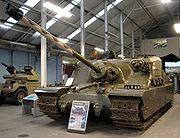
Ordnance QF 32 pounder
Encyclopedia

Ordnance QF 17 pounder
The Ordnance Quick-Firing 17 pounder was a 76.2 mm gun developed by the United Kingdom during World War II. It was used as an anti-tank gun on its own carriage, as well as equipping a number of British tanks. It was the most effective Allied anti-tank gun of the war...
(17-pdr) anti tank and tank
Tank
A tank is a tracked, armoured fighting vehicle designed for front-line combat which combines operational mobility, tactical offensive, and defensive capabilities...
gun.
Like the German 88 mm gun
88 mm gun
The 88 mm gun was a German anti-aircraft and anti-tank artillery gun from World War II. It was widely used by Germany throughout the war, and was one of the most recognizable German weapons of the war...
it was developed from an anti-aircraft
Anti-aircraft warfare
NATO defines air defence as "all measures designed to nullify or reduce the effectiveness of hostile air action." They include ground and air based weapon systems, associated sensor systems, command and control arrangements and passive measures. It may be to protect naval, ground and air forces...
(AA) gun, in this case the QF 3.7 inch AA gun
QF 3.7 inch AA gun
The 3.7-Inch QF AA was Britain's primary heavy anti-aircraft gun during World War II. It was roughly the equivalent of the German 88 mm FlaK but with a slightly larger calibre of 94 mm and superior performance. It was used throughout World War II in all theatres except the Eastern Front...
.
Developed during World War II
World War II
World War II, or the Second World War , was a global conflict lasting from 1939 to 1945, involving most of the world's nations—including all of the great powers—eventually forming two opposing military alliances: the Allies and the Axis...
the gun was used in the experimental Tortoise heavy tank
Tortoise heavy assault tank
The Tank, Heavy Assault, Tortoise was a British heavy assault tank design developed in World War II but never put into mass production. It was developed for the task of clearing heavily fortified areas and as a result favoured armour protection over mobility.Although heavy, at 78 tons, and not...
and as a trial installation in a single de Havilland Mosquito
De Havilland Mosquito
The de Havilland DH.98 Mosquito was a British multi-role combat aircraft that served during the Second World War and the postwar era. It was known affectionately as the "Mossie" to its crews and was also nicknamed "The Wooden Wonder"...
fighter bomber.
The 32-pdr fired a 32 lb
Pound (mass)
The pound or pound-mass is a unit of mass used in the Imperial, United States customary and other systems of measurement...
armour piercing shot
Armor-piercing shot and shell
An armor-piercing shell is a type of ammunition designed to penetrate armor. From the 1860s to 1950s, a major application of armor-piercing projectiles was to defeat the thick armor carried on many warships. From the 1920s onwards, armor-piercing weapons were required for anti-tank missions...
at a muzzle velocity
Muzzle velocity
Muzzle velocity is the speed a projectile has at the moment it leaves the muzzle of the gun. Muzzle velocities range from approximately to in black powder muskets , to more than in modern rifles with high-performance cartridges such as the .220 Swift and .204 Ruger, all the way to for tank guns...
of 2880 ft/s.
Development was halted with the end of the war, and the 17-pdr was replaced with the 20-pdr
Ordnance QF 20 pounder
The Ordnance QF 20 pounder was a British 84 mm tank gun introduced in 1948 and used in the Centurion tank and the Charioteer tank destroyer...
for tank use, and with the intention to develop guided weapons for infantry use.

